Project Plan: CQ University Indigenous Cultural Awareness Training
VerifiedAdded on 2020/06/05
|18
|2691
|117
Project
AI Summary
This project plan outlines the development and implementation of an Indigenous Cultural Awareness Training program aimed at promoting understanding of Indigenous perspectives and cultural awareness within the School of Engineering and Technology (SET) at CQ University. The plan details the project's background, objectives, and benefits, emphasizing improved cultural awareness among students and staff. It includes a comprehensive stakeholder analysis, requirements management strategies, and a detailed work breakdown structure (WBS) for the training program. The plan also provides a project schedule, budget, and risk assessment, along with considerations for tolerances and lessons learned. The project leverages PRINCE2 principles, covering aspects from needs assessment and training content to delivery modes, ensuring a structured approach to achieving its goals. The document provides a thorough approach to project management, covering key elements such as stakeholder engagement, requirements gathering, and risk management. The budget breakdown and schedule provide a realistic overview of the project's execution.
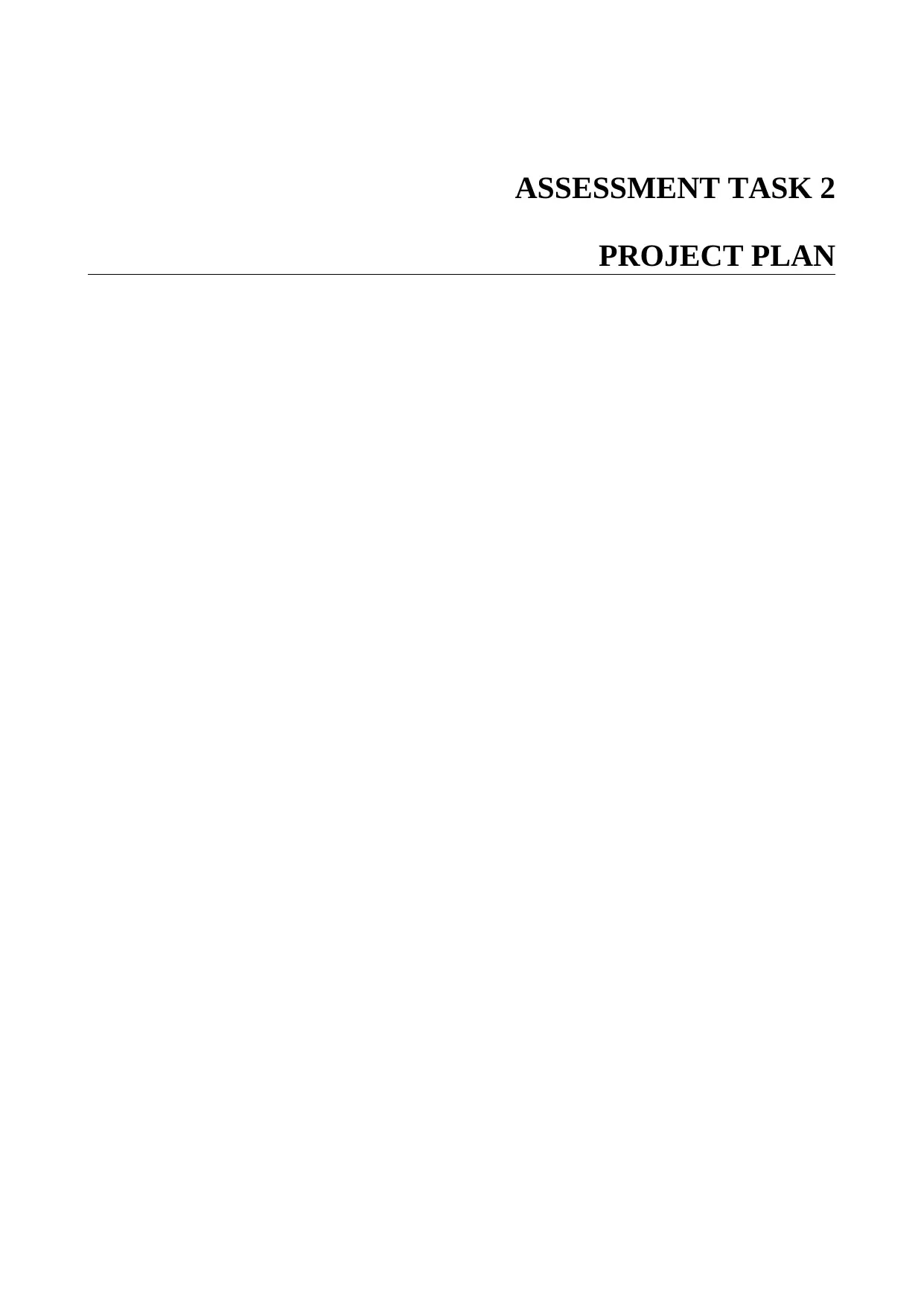
ASSESSMENT TASK 2
PROJECT PLAN
PROJECT PLAN
Paraphrase This Document
Need a fresh take? Get an instant paraphrase of this document with our AI Paraphraser
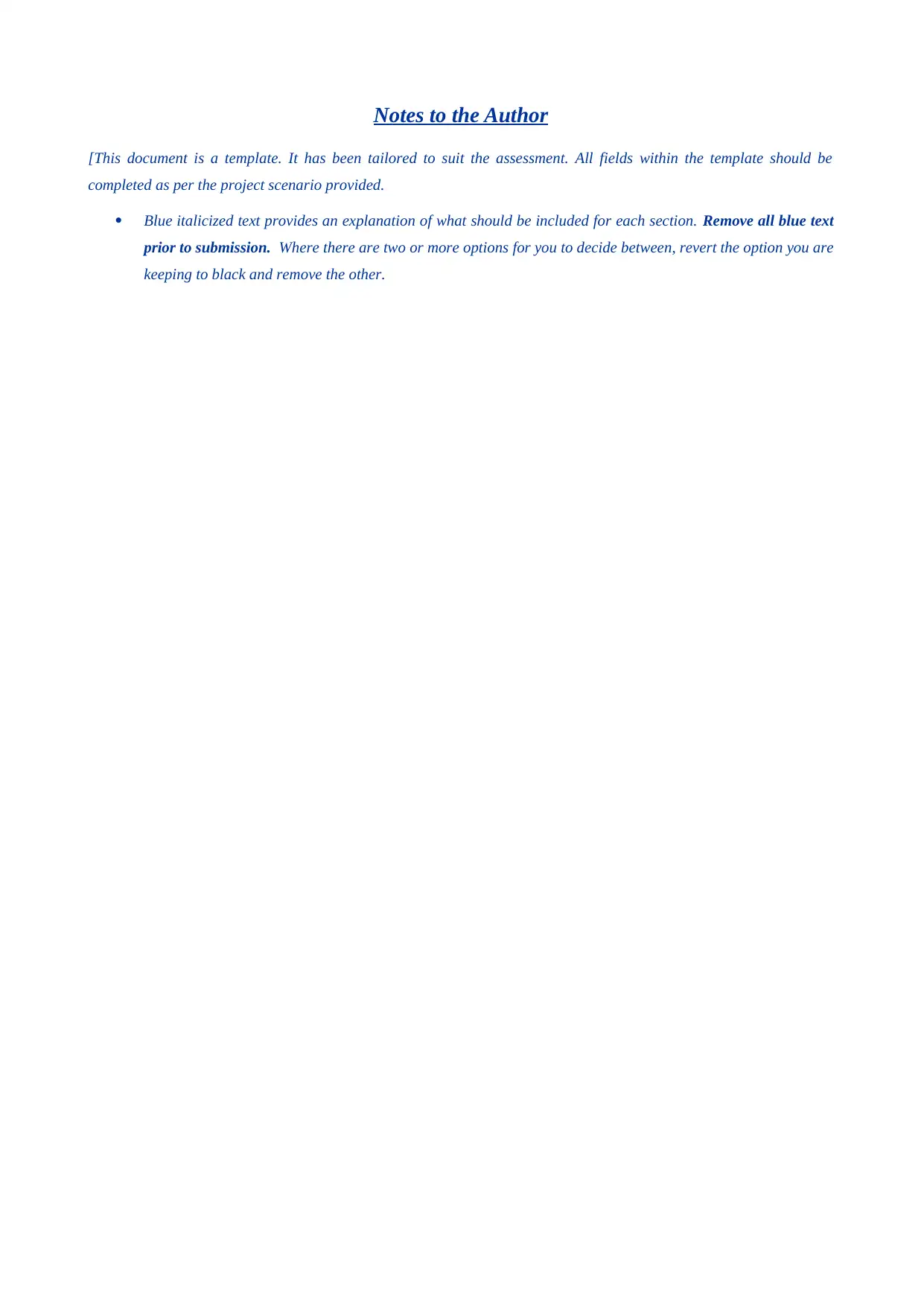
Notes to the Author
[This document is a template. It has been tailored to suit the assessment. All fields within the template should be
completed as per the project scenario provided.
Blue italicized text provides an explanation of what should be included for each section. Remove all blue text
prior to submission. Where there are two or more options for you to decide between, revert the option you are
keeping to black and remove the other.
[This document is a template. It has been tailored to suit the assessment. All fields within the template should be
completed as per the project scenario provided.
Blue italicized text provides an explanation of what should be included for each section. Remove all blue text
prior to submission. Where there are two or more options for you to decide between, revert the option you are
keeping to black and remove the other.
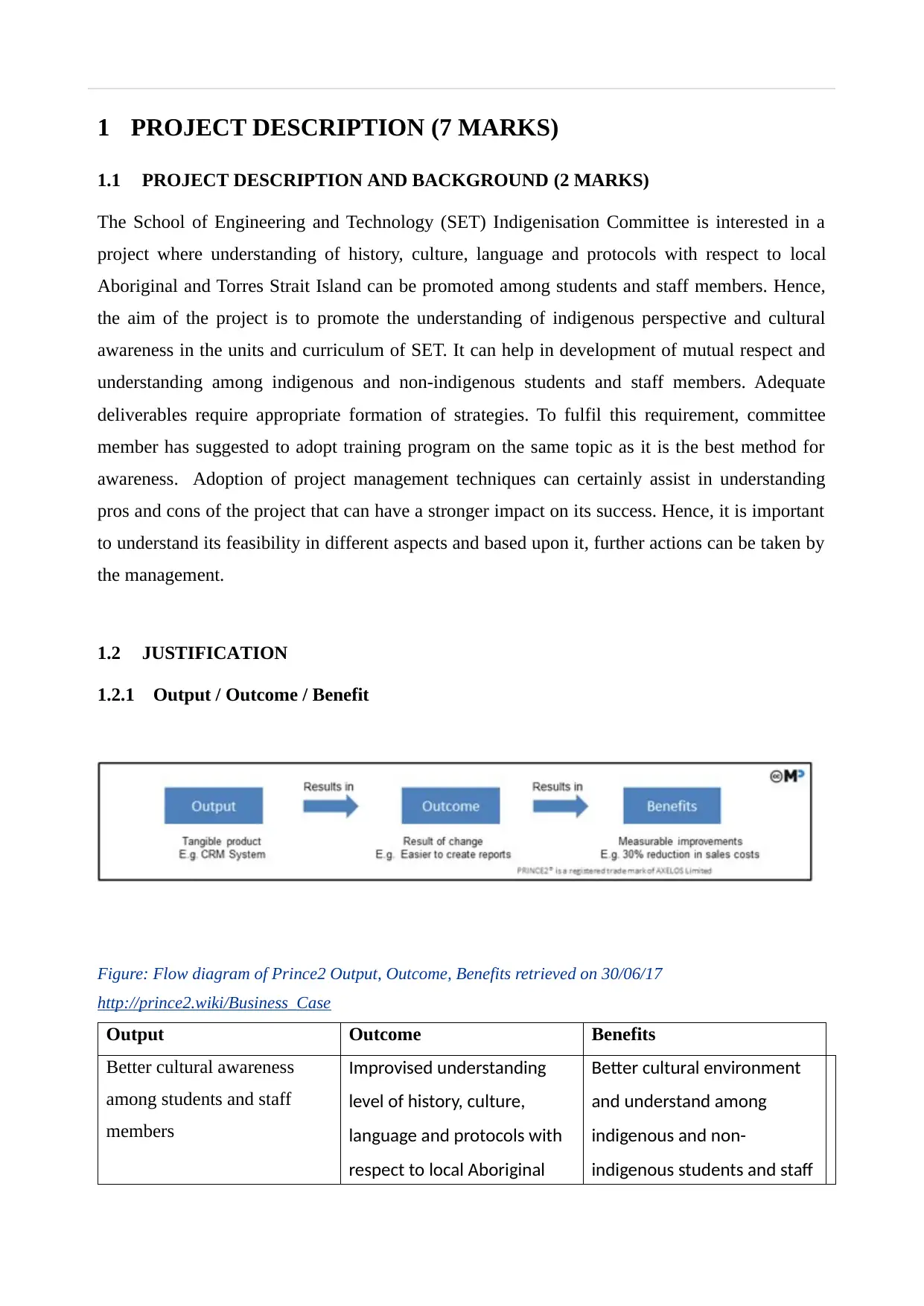
1 PROJECT DESCRIPTION (7 MARKS)
1.1 PROJECT DESCRIPTION AND BACKGROUND (2 MARKS)
The School of Engineering and Technology (SET) Indigenisation Committee is interested in a
project where understanding of history, culture, language and protocols with respect to local
Aboriginal and Torres Strait Island can be promoted among students and staff members. Hence,
the aim of the project is to promote the understanding of indigenous perspective and cultural
awareness in the units and curriculum of SET. It can help in development of mutual respect and
understanding among indigenous and non-indigenous students and staff members. Adequate
deliverables require appropriate formation of strategies. To fulfil this requirement, committee
member has suggested to adopt training program on the same topic as it is the best method for
awareness. Adoption of project management techniques can certainly assist in understanding
pros and cons of the project that can have a stronger impact on its success. Hence, it is important
to understand its feasibility in different aspects and based upon it, further actions can be taken by
the management.
1.2 JUSTIFICATION
1.2.1 Output / Outcome / Benefit
Figure: Flow diagram of Prince2 Output, Outcome, Benefits retrieved on 30/06/17
http://prince2.wiki/Business_Case
Output Outcome Benefits
Better cultural awareness
among students and staff
members
Improvised understanding
level of history, culture,
language and protocols with
respect to local Aboriginal
Better cultural environment
and understand among
indigenous and non-
indigenous students and staff
1.1 PROJECT DESCRIPTION AND BACKGROUND (2 MARKS)
The School of Engineering and Technology (SET) Indigenisation Committee is interested in a
project where understanding of history, culture, language and protocols with respect to local
Aboriginal and Torres Strait Island can be promoted among students and staff members. Hence,
the aim of the project is to promote the understanding of indigenous perspective and cultural
awareness in the units and curriculum of SET. It can help in development of mutual respect and
understanding among indigenous and non-indigenous students and staff members. Adequate
deliverables require appropriate formation of strategies. To fulfil this requirement, committee
member has suggested to adopt training program on the same topic as it is the best method for
awareness. Adoption of project management techniques can certainly assist in understanding
pros and cons of the project that can have a stronger impact on its success. Hence, it is important
to understand its feasibility in different aspects and based upon it, further actions can be taken by
the management.
1.2 JUSTIFICATION
1.2.1 Output / Outcome / Benefit
Figure: Flow diagram of Prince2 Output, Outcome, Benefits retrieved on 30/06/17
http://prince2.wiki/Business_Case
Output Outcome Benefits
Better cultural awareness
among students and staff
members
Improvised understanding
level of history, culture,
language and protocols with
respect to local Aboriginal
Better cultural environment
and understand among
indigenous and non-
indigenous students and staff
⊘ This is a preview!⊘
Do you want full access?
Subscribe today to unlock all pages.

Trusted by 1+ million students worldwide
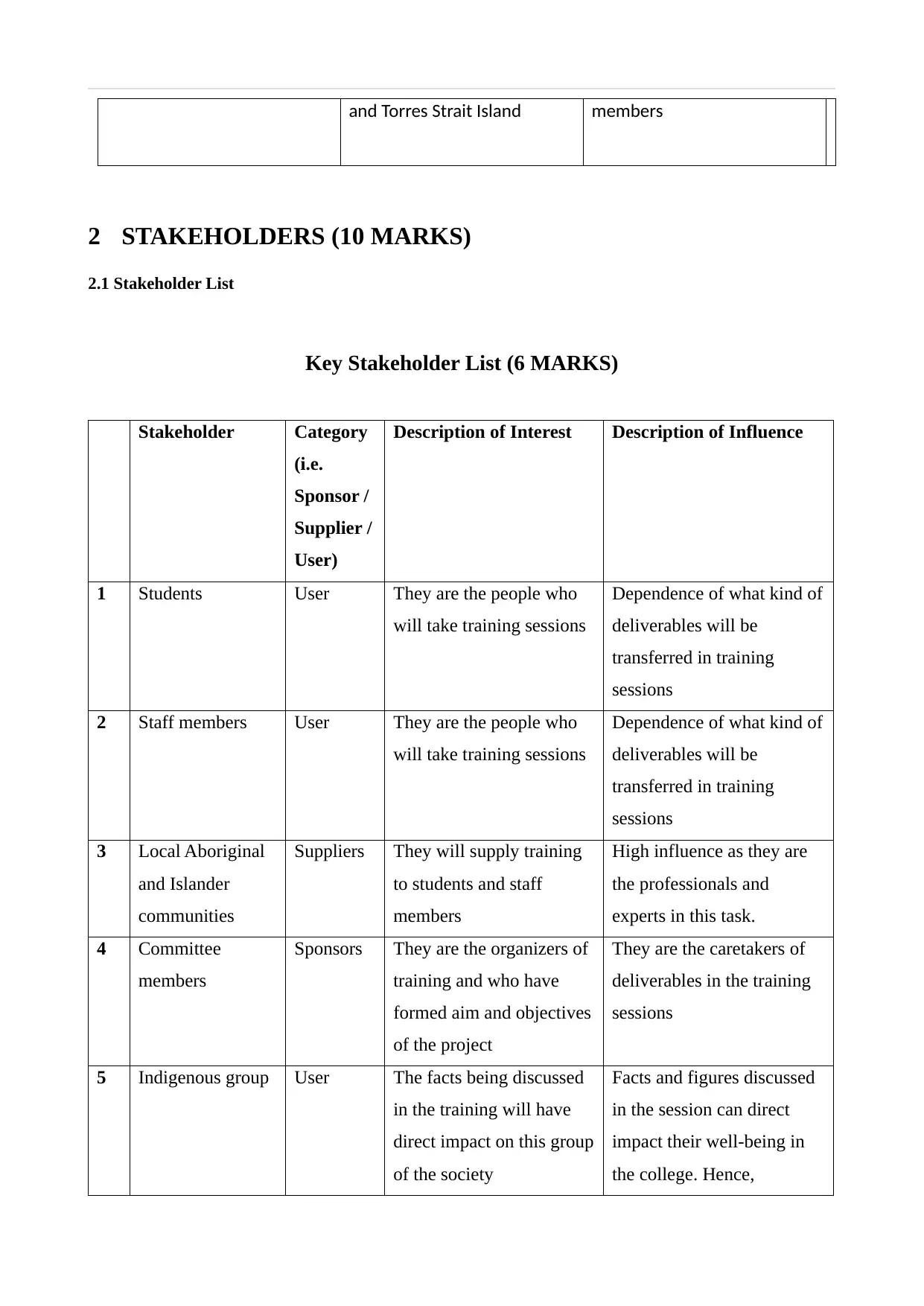
and Torres Strait Island members
2 STAKEHOLDERS (10 MARKS)
2.1 Stakeholder List
Key Stakeholder List (6 MARKS)
Stakeholder Category
(i.e.
Sponsor /
Supplier /
User)
Description of Interest Description of Influence
1 Students User They are the people who
will take training sessions
Dependence of what kind of
deliverables will be
transferred in training
sessions
2 Staff members User They are the people who
will take training sessions
Dependence of what kind of
deliverables will be
transferred in training
sessions
3 Local Aboriginal
and Islander
communities
Suppliers They will supply training
to students and staff
members
High influence as they are
the professionals and
experts in this task.
4 Committee
members
Sponsors They are the organizers of
training and who have
formed aim and objectives
of the project
They are the caretakers of
deliverables in the training
sessions
5 Indigenous group User The facts being discussed
in the training will have
direct impact on this group
of the society
Facts and figures discussed
in the session can direct
impact their well-being in
the college. Hence,
2 STAKEHOLDERS (10 MARKS)
2.1 Stakeholder List
Key Stakeholder List (6 MARKS)
Stakeholder Category
(i.e.
Sponsor /
Supplier /
User)
Description of Interest Description of Influence
1 Students User They are the people who
will take training sessions
Dependence of what kind of
deliverables will be
transferred in training
sessions
2 Staff members User They are the people who
will take training sessions
Dependence of what kind of
deliverables will be
transferred in training
sessions
3 Local Aboriginal
and Islander
communities
Suppliers They will supply training
to students and staff
members
High influence as they are
the professionals and
experts in this task.
4 Committee
members
Sponsors They are the organizers of
training and who have
formed aim and objectives
of the project
They are the caretakers of
deliverables in the training
sessions
5 Indigenous group User The facts being discussed
in the training will have
direct impact on this group
of the society
Facts and figures discussed
in the session can direct
impact their well-being in
the college. Hence,
Paraphrase This Document
Need a fresh take? Get an instant paraphrase of this document with our AI Paraphraser
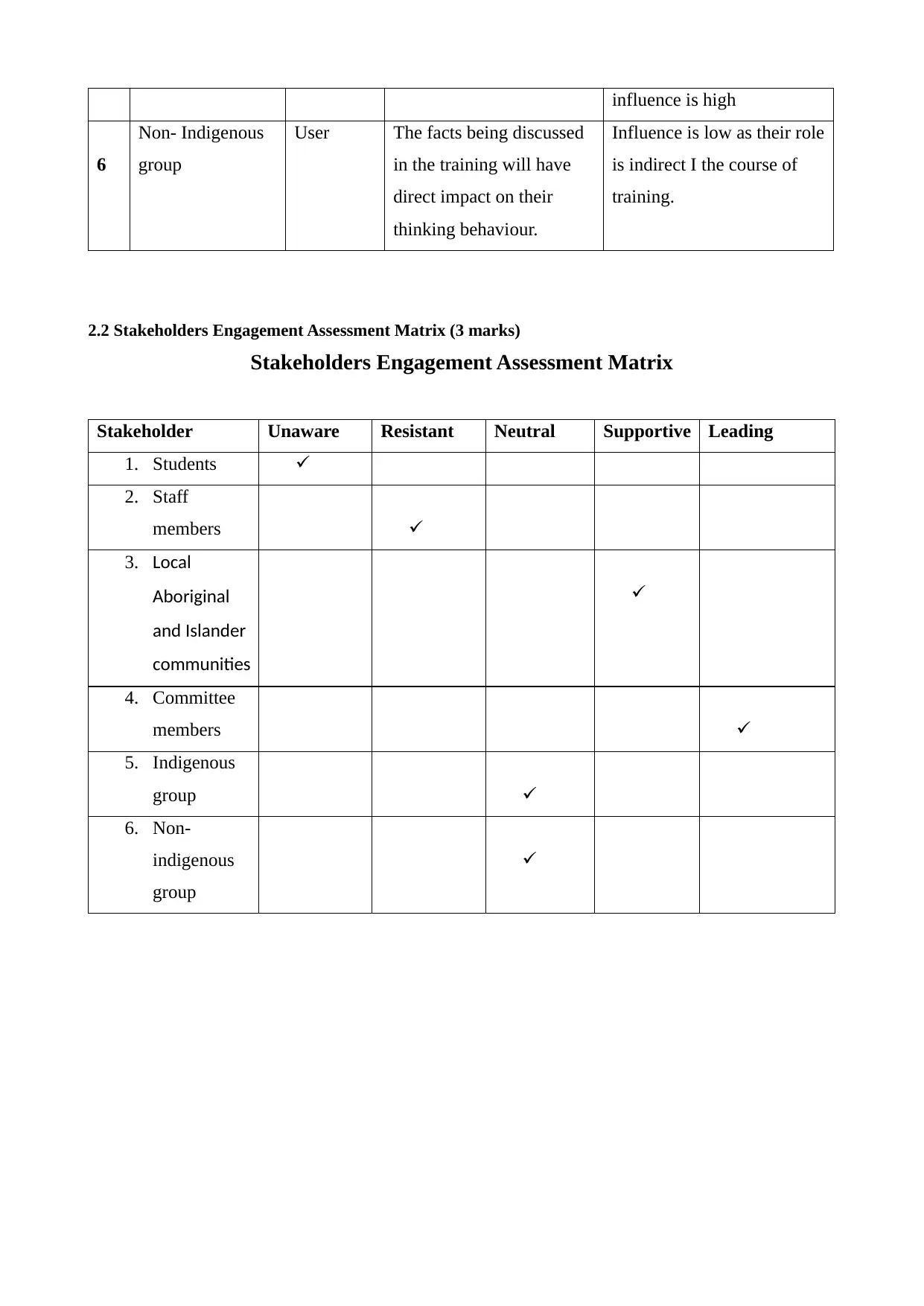
influence is high
6
Non- Indigenous
group
User The facts being discussed
in the training will have
direct impact on their
thinking behaviour.
Influence is low as their role
is indirect I the course of
training.
2.2 Stakeholders Engagement Assessment Matrix (3 marks)
Stakeholders Engagement Assessment Matrix
Stakeholder Unaware Resistant Neutral Supportive Leading
1. Students
2. Staff
members
3. Local
Aboriginal
and Islander
communities
4. Committee
members
5. Indigenous
group
6. Non-
indigenous
group
6
Non- Indigenous
group
User The facts being discussed
in the training will have
direct impact on their
thinking behaviour.
Influence is low as their role
is indirect I the course of
training.
2.2 Stakeholders Engagement Assessment Matrix (3 marks)
Stakeholders Engagement Assessment Matrix
Stakeholder Unaware Resistant Neutral Supportive Leading
1. Students
2. Staff
members
3. Local
Aboriginal
and Islander
communities
4. Committee
members
5. Indigenous
group
6. Non-
indigenous
group
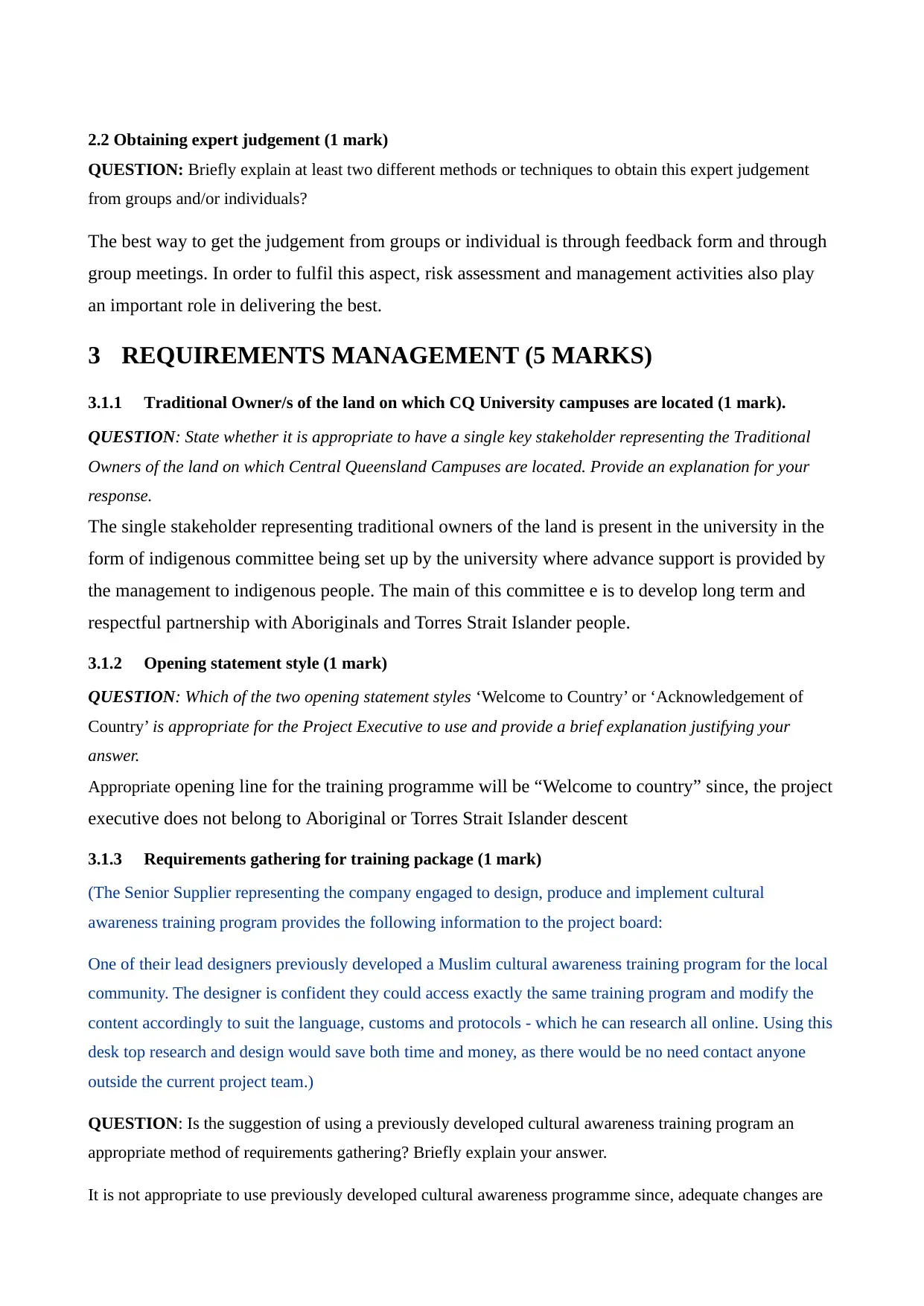
2.2 Obtaining expert judgement (1 mark)
QUESTION: Briefly explain at least two different methods or techniques to obtain this expert judgement
from groups and/or individuals?
The best way to get the judgement from groups or individual is through feedback form and through
group meetings. In order to fulfil this aspect, risk assessment and management activities also play
an important role in delivering the best.
3 REQUIREMENTS MANAGEMENT (5 MARKS)
3.1.1 Traditional Owner/s of the land on which CQ University campuses are located (1 mark).
QUESTION: State whether it is appropriate to have a single key stakeholder representing the Traditional
Owners of the land on which Central Queensland Campuses are located. Provide an explanation for your
response.
The single stakeholder representing traditional owners of the land is present in the university in the
form of indigenous committee being set up by the university where advance support is provided by
the management to indigenous people. The main of this committee e is to develop long term and
respectful partnership with Aboriginals and Torres Strait Islander people.
3.1.2 Opening statement style (1 mark)
QUESTION: Which of the two opening statement styles ‘Welcome to Country’ or ‘Acknowledgement of
Country’ is appropriate for the Project Executive to use and provide a brief explanation justifying your
answer.
Appropriate opening line for the training programme will be “Welcome to country” since, the project
executive does not belong to Aboriginal or Torres Strait Islander descent
3.1.3 Requirements gathering for training package (1 mark)
(The Senior Supplier representing the company engaged to design, produce and implement cultural
awareness training program provides the following information to the project board:
One of their lead designers previously developed a Muslim cultural awareness training program for the local
community. The designer is confident they could access exactly the same training program and modify the
content accordingly to suit the language, customs and protocols - which he can research all online. Using this
desk top research and design would save both time and money, as there would be no need contact anyone
outside the current project team.)
QUESTION: Is the suggestion of using a previously developed cultural awareness training program an
appropriate method of requirements gathering? Briefly explain your answer.
It is not appropriate to use previously developed cultural awareness programme since, adequate changes are
QUESTION: Briefly explain at least two different methods or techniques to obtain this expert judgement
from groups and/or individuals?
The best way to get the judgement from groups or individual is through feedback form and through
group meetings. In order to fulfil this aspect, risk assessment and management activities also play
an important role in delivering the best.
3 REQUIREMENTS MANAGEMENT (5 MARKS)
3.1.1 Traditional Owner/s of the land on which CQ University campuses are located (1 mark).
QUESTION: State whether it is appropriate to have a single key stakeholder representing the Traditional
Owners of the land on which Central Queensland Campuses are located. Provide an explanation for your
response.
The single stakeholder representing traditional owners of the land is present in the university in the
form of indigenous committee being set up by the university where advance support is provided by
the management to indigenous people. The main of this committee e is to develop long term and
respectful partnership with Aboriginals and Torres Strait Islander people.
3.1.2 Opening statement style (1 mark)
QUESTION: Which of the two opening statement styles ‘Welcome to Country’ or ‘Acknowledgement of
Country’ is appropriate for the Project Executive to use and provide a brief explanation justifying your
answer.
Appropriate opening line for the training programme will be “Welcome to country” since, the project
executive does not belong to Aboriginal or Torres Strait Islander descent
3.1.3 Requirements gathering for training package (1 mark)
(The Senior Supplier representing the company engaged to design, produce and implement cultural
awareness training program provides the following information to the project board:
One of their lead designers previously developed a Muslim cultural awareness training program for the local
community. The designer is confident they could access exactly the same training program and modify the
content accordingly to suit the language, customs and protocols - which he can research all online. Using this
desk top research and design would save both time and money, as there would be no need contact anyone
outside the current project team.)
QUESTION: Is the suggestion of using a previously developed cultural awareness training program an
appropriate method of requirements gathering? Briefly explain your answer.
It is not appropriate to use previously developed cultural awareness programme since, adequate changes are
⊘ This is a preview!⊘
Do you want full access?
Subscribe today to unlock all pages.

Trusted by 1+ million students worldwide
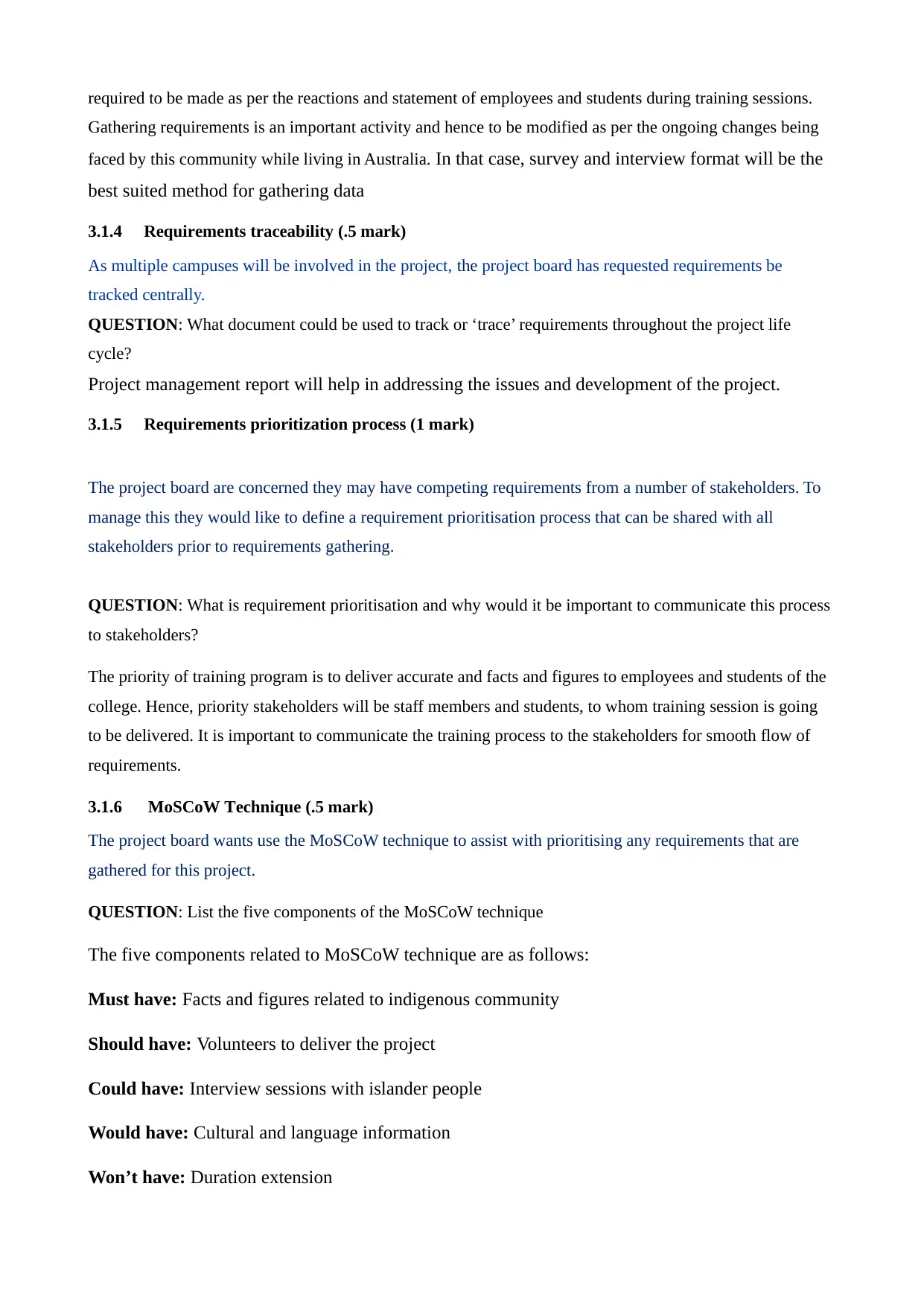
required to be made as per the reactions and statement of employees and students during training sessions.
Gathering requirements is an important activity and hence to be modified as per the ongoing changes being
faced by this community while living in Australia. In that case, survey and interview format will be the
best suited method for gathering data
3.1.4 Requirements traceability (.5 mark)
As multiple campuses will be involved in the project, the project board has requested requirements be
tracked centrally.
QUESTION: What document could be used to track or ‘trace’ requirements throughout the project life
cycle?
Project management report will help in addressing the issues and development of the project.
3.1.5 Requirements prioritization process (1 mark)
The project board are concerned they may have competing requirements from a number of stakeholders. To
manage this they would like to define a requirement prioritisation process that can be shared with all
stakeholders prior to requirements gathering.
QUESTION: What is requirement prioritisation and why would it be important to communicate this process
to stakeholders?
The priority of training program is to deliver accurate and facts and figures to employees and students of the
college. Hence, priority stakeholders will be staff members and students, to whom training session is going
to be delivered. It is important to communicate the training process to the stakeholders for smooth flow of
requirements.
3.1.6 MoSCoW Technique (.5 mark)
The project board wants use the MoSCoW technique to assist with prioritising any requirements that are
gathered for this project.
QUESTION: List the five components of the MoSCoW technique
The five components related to MoSCoW technique are as follows:
Must have: Facts and figures related to indigenous community
Should have: Volunteers to deliver the project
Could have: Interview sessions with islander people
Would have: Cultural and language information
Won’t have: Duration extension
Gathering requirements is an important activity and hence to be modified as per the ongoing changes being
faced by this community while living in Australia. In that case, survey and interview format will be the
best suited method for gathering data
3.1.4 Requirements traceability (.5 mark)
As multiple campuses will be involved in the project, the project board has requested requirements be
tracked centrally.
QUESTION: What document could be used to track or ‘trace’ requirements throughout the project life
cycle?
Project management report will help in addressing the issues and development of the project.
3.1.5 Requirements prioritization process (1 mark)
The project board are concerned they may have competing requirements from a number of stakeholders. To
manage this they would like to define a requirement prioritisation process that can be shared with all
stakeholders prior to requirements gathering.
QUESTION: What is requirement prioritisation and why would it be important to communicate this process
to stakeholders?
The priority of training program is to deliver accurate and facts and figures to employees and students of the
college. Hence, priority stakeholders will be staff members and students, to whom training session is going
to be delivered. It is important to communicate the training process to the stakeholders for smooth flow of
requirements.
3.1.6 MoSCoW Technique (.5 mark)
The project board wants use the MoSCoW technique to assist with prioritising any requirements that are
gathered for this project.
QUESTION: List the five components of the MoSCoW technique
The five components related to MoSCoW technique are as follows:
Must have: Facts and figures related to indigenous community
Should have: Volunteers to deliver the project
Could have: Interview sessions with islander people
Would have: Cultural and language information
Won’t have: Duration extension
Paraphrase This Document
Need a fresh take? Get an instant paraphrase of this document with our AI Paraphraser
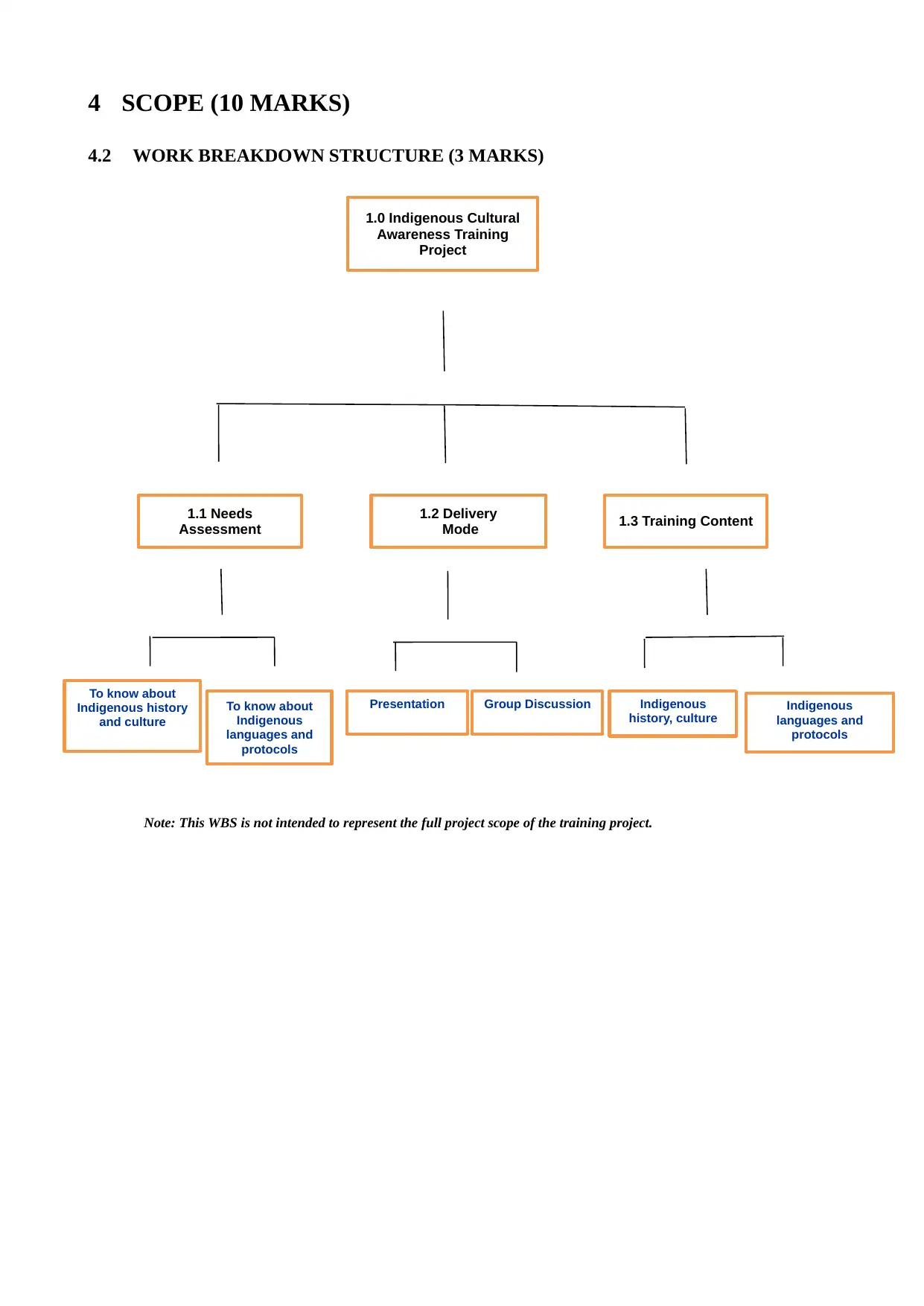
4 SCOPE (10 MARKS)
4.2 WORK BREAKDOWN STRUCTURE (3 MARKS)
Note: This WBS is not intended to represent the full project scope of the training project.
1.0 Indigenous Cultural
Awareness Training
Project
1.3 Training Content
1.2 Delivery
Mode
1.1 Needs
Assessment
Indigenous
languages and
protocols
Indigenous
history, culture
Group DiscussionPresentationTo know about
Indigenous
languages and
protocols
To know about
Indigenous history
and culture
4.2 WORK BREAKDOWN STRUCTURE (3 MARKS)
Note: This WBS is not intended to represent the full project scope of the training project.
1.0 Indigenous Cultural
Awareness Training
Project
1.3 Training Content
1.2 Delivery
Mode
1.1 Needs
Assessment
Indigenous
languages and
protocols
Indigenous
history, culture
Group DiscussionPresentationTo know about
Indigenous
languages and
protocols
To know about
Indigenous history
and culture
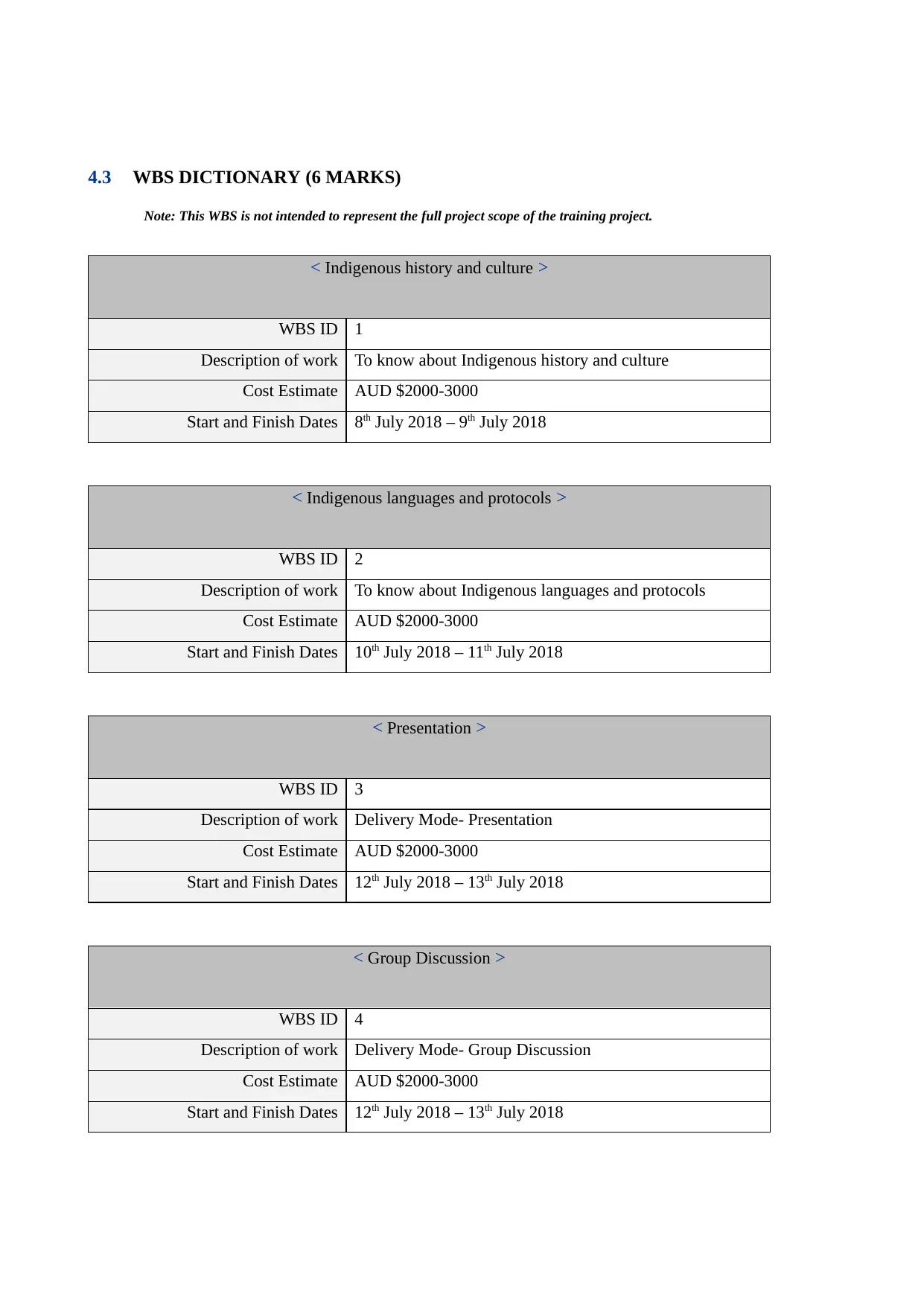
4.3 WBS DICTIONARY (6 MARKS)
Note: This WBS is not intended to represent the full project scope of the training project.
< Indigenous history and culture >
WBS ID 1
Description of work To know about Indigenous history and culture
Cost Estimate AUD $2000-3000
Start and Finish Dates 8th July 2018 – 9th July 2018
< Indigenous languages and protocols >
WBS ID 2
Description of work To know about Indigenous languages and protocols
Cost Estimate AUD $2000-3000
Start and Finish Dates 10th July 2018 – 11th July 2018
< Presentation >
WBS ID 3
Description of work Delivery Mode- Presentation
Cost Estimate AUD $2000-3000
Start and Finish Dates 12th July 2018 – 13th July 2018
< Group Discussion >
WBS ID 4
Description of work Delivery Mode- Group Discussion
Cost Estimate AUD $2000-3000
Start and Finish Dates 12th July 2018 – 13th July 2018
Note: This WBS is not intended to represent the full project scope of the training project.
< Indigenous history and culture >
WBS ID 1
Description of work To know about Indigenous history and culture
Cost Estimate AUD $2000-3000
Start and Finish Dates 8th July 2018 – 9th July 2018
< Indigenous languages and protocols >
WBS ID 2
Description of work To know about Indigenous languages and protocols
Cost Estimate AUD $2000-3000
Start and Finish Dates 10th July 2018 – 11th July 2018
< Presentation >
WBS ID 3
Description of work Delivery Mode- Presentation
Cost Estimate AUD $2000-3000
Start and Finish Dates 12th July 2018 – 13th July 2018
< Group Discussion >
WBS ID 4
Description of work Delivery Mode- Group Discussion
Cost Estimate AUD $2000-3000
Start and Finish Dates 12th July 2018 – 13th July 2018
⊘ This is a preview!⊘
Do you want full access?
Subscribe today to unlock all pages.

Trusted by 1+ million students worldwide
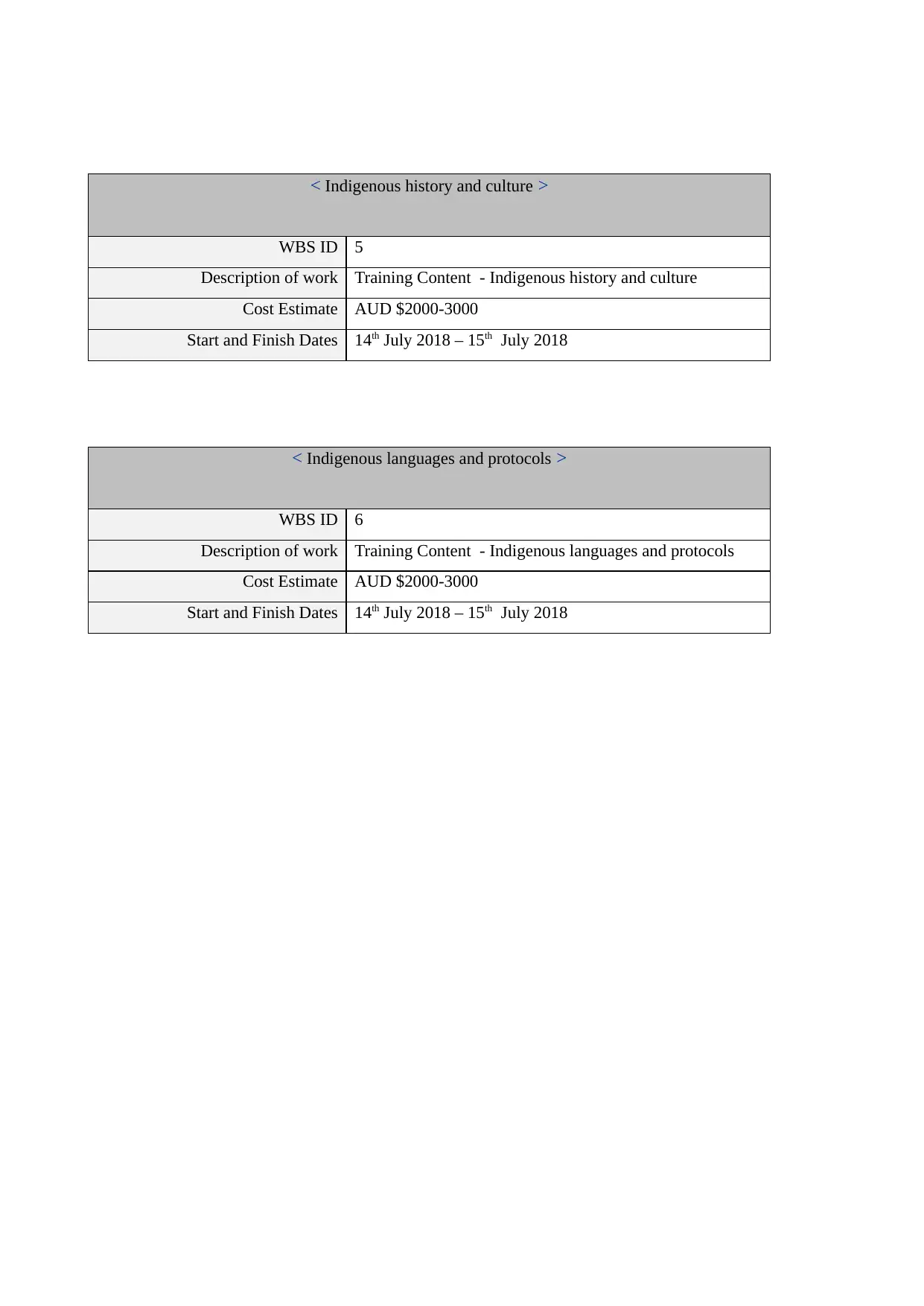
< Indigenous history and culture >
WBS ID 5
Description of work Training Content - Indigenous history and culture
Cost Estimate AUD $2000-3000
Start and Finish Dates 14th July 2018 – 15th July 2018
< Indigenous languages and protocols >
WBS ID 6
Description of work Training Content - Indigenous languages and protocols
Cost Estimate AUD $2000-3000
Start and Finish Dates 14th July 2018 – 15th July 2018
WBS ID 5
Description of work Training Content - Indigenous history and culture
Cost Estimate AUD $2000-3000
Start and Finish Dates 14th July 2018 – 15th July 2018
< Indigenous languages and protocols >
WBS ID 6
Description of work Training Content - Indigenous languages and protocols
Cost Estimate AUD $2000-3000
Start and Finish Dates 14th July 2018 – 15th July 2018
Paraphrase This Document
Need a fresh take? Get an instant paraphrase of this document with our AI Paraphraser
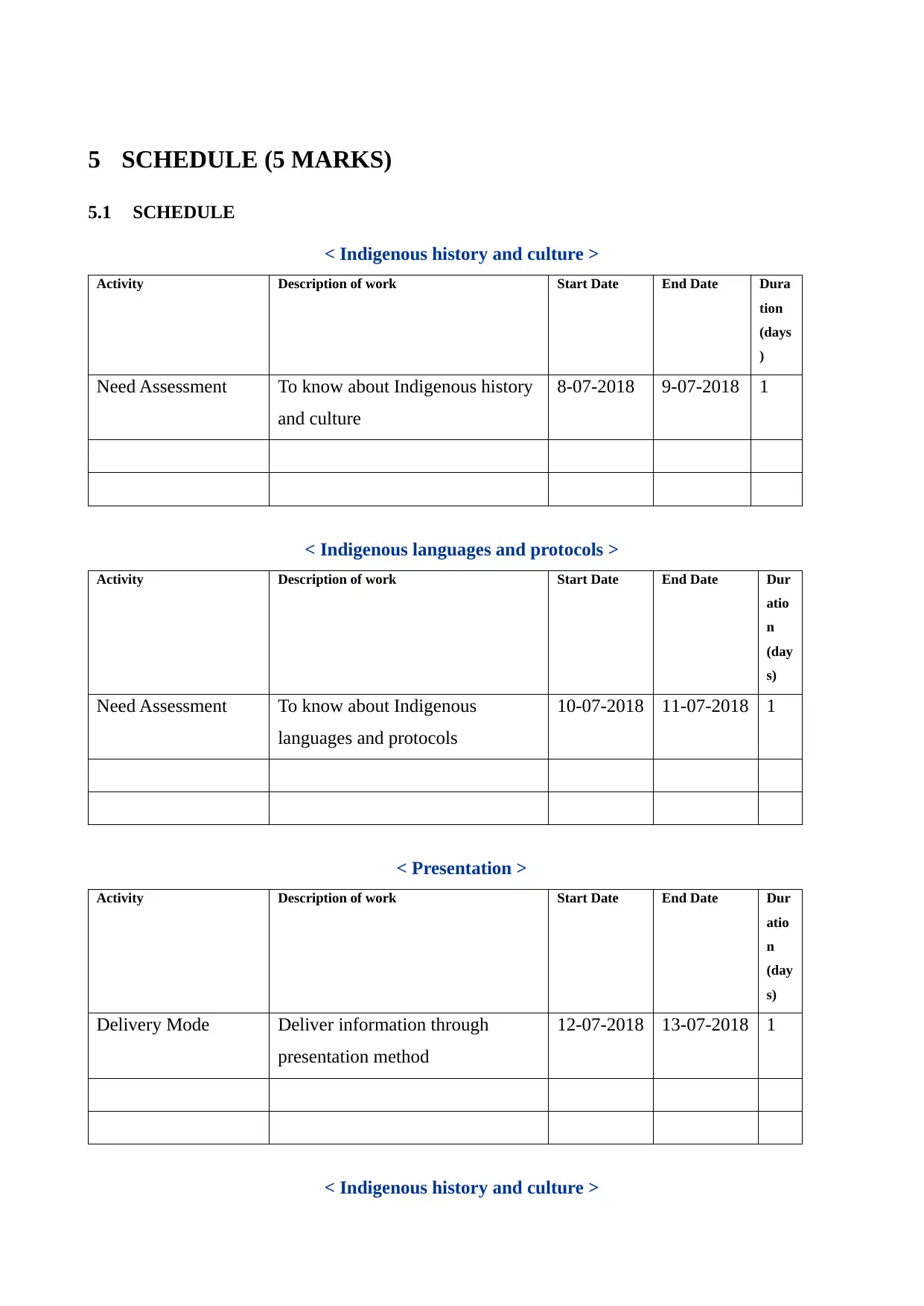
5 SCHEDULE (5 MARKS)
5.1 SCHEDULE
< Indigenous history and culture >
Activity Description of work Start Date End Date Dura
tion
(days
)
Need Assessment To know about Indigenous history
and culture
8-07-2018 9-07-2018 1
< Indigenous languages and protocols >
Activity Description of work Start Date End Date Dur
atio
n
(day
s)
Need Assessment To know about Indigenous
languages and protocols
10-07-2018 11-07-2018 1
< Presentation >
Activity Description of work Start Date End Date Dur
atio
n
(day
s)
Delivery Mode Deliver information through
presentation method
12-07-2018 13-07-2018 1
< Indigenous history and culture >
5.1 SCHEDULE
< Indigenous history and culture >
Activity Description of work Start Date End Date Dura
tion
(days
)
Need Assessment To know about Indigenous history
and culture
8-07-2018 9-07-2018 1
< Indigenous languages and protocols >
Activity Description of work Start Date End Date Dur
atio
n
(day
s)
Need Assessment To know about Indigenous
languages and protocols
10-07-2018 11-07-2018 1
< Presentation >
Activity Description of work Start Date End Date Dur
atio
n
(day
s)
Delivery Mode Deliver information through
presentation method
12-07-2018 13-07-2018 1
< Indigenous history and culture >
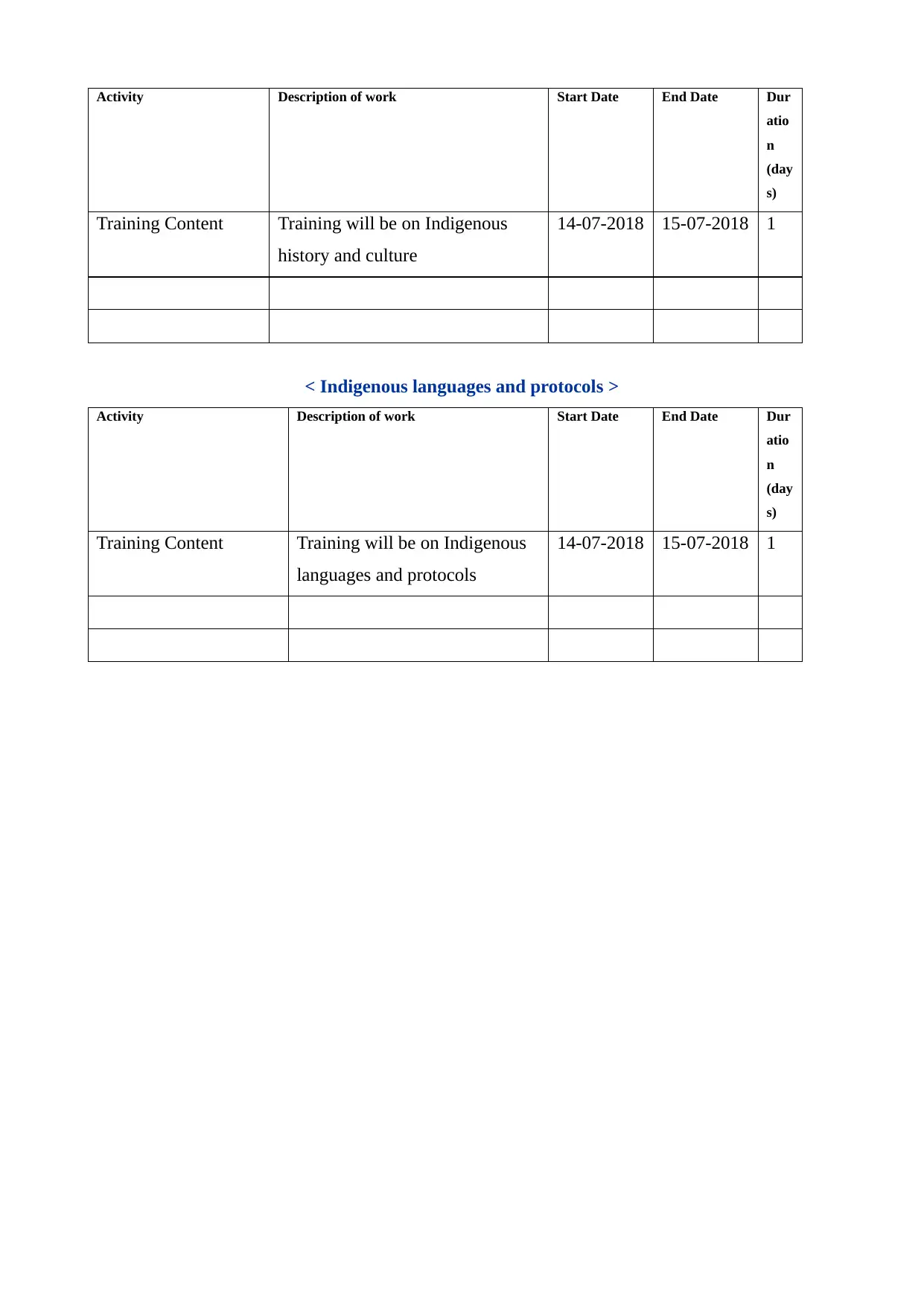
Activity Description of work Start Date End Date Dur
atio
n
(day
s)
Training Content Training will be on Indigenous
history and culture
14-07-2018 15-07-2018 1
< Indigenous languages and protocols >
Activity Description of work Start Date End Date Dur
atio
n
(day
s)
Training Content Training will be on Indigenous
languages and protocols
14-07-2018 15-07-2018 1
atio
n
(day
s)
Training Content Training will be on Indigenous
history and culture
14-07-2018 15-07-2018 1
< Indigenous languages and protocols >
Activity Description of work Start Date End Date Dur
atio
n
(day
s)
Training Content Training will be on Indigenous
languages and protocols
14-07-2018 15-07-2018 1
⊘ This is a preview!⊘
Do you want full access?
Subscribe today to unlock all pages.

Trusted by 1+ million students worldwide
1 out of 18
Related Documents
Your All-in-One AI-Powered Toolkit for Academic Success.
+13062052269
info@desklib.com
Available 24*7 on WhatsApp / Email
![[object Object]](/_next/static/media/star-bottom.7253800d.svg)
Unlock your academic potential
Copyright © 2020–2025 A2Z Services. All Rights Reserved. Developed and managed by ZUCOL.





